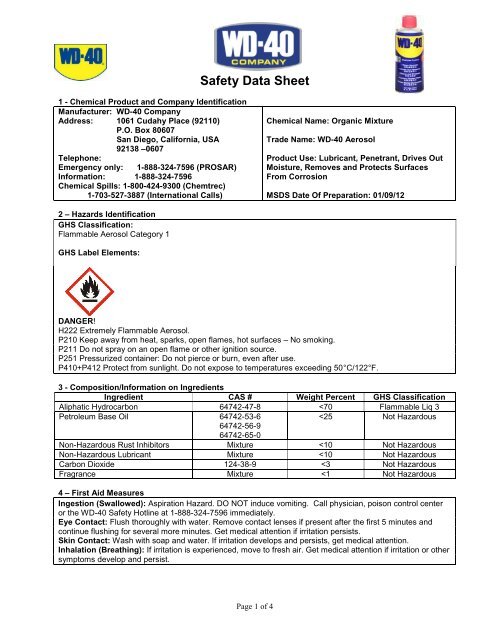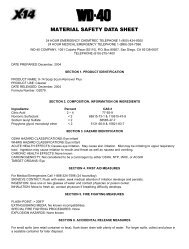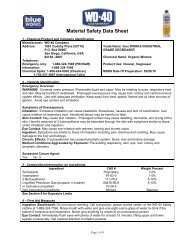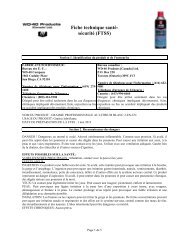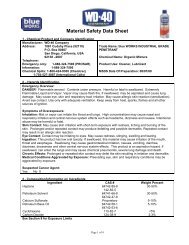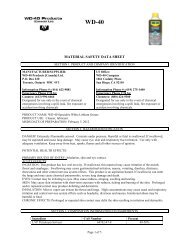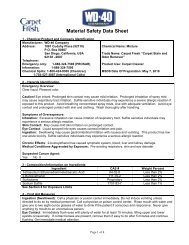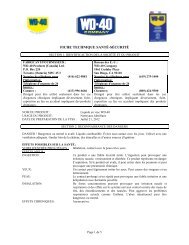Material Safety Data Sheet (MSDS) - WD-40 Company
Material Safety Data Sheet (MSDS) - WD-40 Company
Material Safety Data Sheet (MSDS) - WD-40 Company
- No tags were found...
You also want an ePaper? Increase the reach of your titles
YUMPU automatically turns print PDFs into web optimized ePapers that Google loves.
<strong>Safety</strong> <strong>Data</strong> <strong>Sheet</strong>1 - Chemical Product and <strong>Company</strong> IdentificationManufacturer: <strong>WD</strong>-<strong>40</strong> <strong>Company</strong>Address: 1061 Cudahy Place (92110)P.O. Box 80607San Diego, California, USA92138 –0607Telephone:Emergency only: 1-888-324-7596 (PROSAR)Information: 1-888-324-7596Chemical Spills: 1-800-424-9300 (Chemtrec)1-703-527-3887 (International Calls)Chemical Name: Organic MixtureTrade Name: <strong>WD</strong>-<strong>40</strong> AerosolProduct Use: Lubricant, Penetrant, Drives OutMoisture, Removes and Protects SurfacesFrom Corrosion<strong>MSDS</strong> Date Of Preparation: 01/09/122 – Hazards IdentificationGHS Classification:Flammable Aerosol Category 1GHS Label Elements:DANGER!H222 Extremely Flammable Aerosol.P210 Keep away from heat, sparks, open flames, hot surfaces – No smoking.P211 Do not spray on an open flame or other ignition source.P251 Pressurized container: Do not pierce or burn, even after use.P410+P412 Protect from sunlight. Do not expose to temperatures exceeding 50°C/122°F.3 - Composition/Information on IngredientsIngredient CAS # Weight Percent GHS ClassificationAliphatic Hydrocarbon 64742-47-8
Signs and Symptoms of Exposure: May cause eye and respiratory irritation. Inhalation may causecoughing, headache and dizziness. Skin contact may cause drying of the skin.5 – Fire Fighting MeasuresExtinguishing Media: Use water fog, dry chemical, carbon dioxide or foam. Do not use water jet or floodingamounts of water. Burning product will float on the surface and spread fire.Special Fire Fighting Procedures: Firefighters should always wear positive pressure self-containedbreathing apparatus and full protective clothing. Cool fire-exposed containers with water. Use shielding toprotect against bursting containers.Unusual Fire and Explosion Hazards: Contents under pressure. Keep away from ignition sources andopen flames. Exposure of containers to extreme heat and flames can cause them to rupture often with violentforce. Vapors are heavier than air and may travel along surfaces to remote ignition sources and flash back.6 – Accidental Release MeasuresWear appropriate protective clothing (see Section 8). Eliminate all sources of ignition and ventilate area.Leaking cans should be placed in a plastic bag or open pail until the pressure has dissipated. Contain andcollect liquid with an inert absorbent and place in a container for disposal. Clean spill area thoroughly. Reportspills to authorities as required.7 – Handling and StorageHandling: Avoid contact with eyes. Avoid prolonged contact with skin. Avoid breathing vapors or aerosols.Use only with adequate ventilation. Keep away from heat, sparks, pilot lights, hot surfaces and open flames.Unplug electrical tools, motors and appliances before spraying or bringing the can near any source ofelectricity. Electricity can burn a hole in the can and cause contents to burst into flames. To avoid seriousburn injury, do not let the can touch battery terminals, electrical connections on motors or appliances or anyother source of electricity. Wash thoroughly with soap and water after handling. Keep containers closed whennot in use. Keep out of the reach of children. Do not puncture, crush or incinerate containers, even whenempty.Storage: Store in a cool, well-ventilated area, away from incompatible materials Do not store above 120F orin direct sunlight. U.F.C (NFPA 30B) Level 3 Aerosol.8 – Exposure Controls/Personal ProtectionChemicalOccupational Exposure LimitsAliphatic HydrocarbonPetroleum Base OilNon-Hazardous Rust InhibitorsNon-Hazardous LubricantCarbon DioxideFragrance1200 mg/m3 TWA (manufacturer recommended)5 mg/m3 (inhalable)ACGIH TLV TWA5 mg/m3 TWA OSHA PELNone EstablishedNone Established5000 ppm TWA (OSHA/ACGIH), 30,000 ppm STEL (ACGIH)None EstablishedThe Following Controls are Recommended for Normal Consumer Use of this ProductEngineering Controls: Use in a well-ventilated area.Personal Protection:Eye Protection: Avoid eye contact. Always spray away from your face.Skin Protection: Avoid prolonged skin contact. Chemical resistant gloves recommended for operationswhere skin contact is likely.Respiratory Protection: None needed for normal use with adequate ventilation.For Bulk Processing or Workplace Use the Following Controls are RecommendedEngineering Controls: Use adequate general and local exhaust ventilation to maintain exposure levelsbelow that occupational exposure limits.Personal Protection:Page 2 of 4
Eye Protection: <strong>Safety</strong> goggles recommended where eye contact is possible.Skin Protection: Wear chemical resistant gloves.Respiratory Protection: None required if ventilation is adequate. If the occupational exposure limits areexceeded, wear a NIOSH approved respirator. Respirator selection and use should be based on contaminanttype, form and concentration. Follow OSHA 1910.134, ANSI Z88.2 and good Industrial Hygiene practice.Work/Hygiene Practices: Wash with soap and water after handling.9 – Physical and Chemical PropertiesBoiling Point: 300F (150°C) Specific Gravity: 0.8 – 0.82 @ 60FSolubility in Water: Insoluble pH: Not ApplicableVapor Pressure: 95-115 PSI @ 70F Vapor Density: Greater than 1Percent Volatile: 65% VOC: 533 grams/liter (65%)Coefficient of Water/Oil Not Determined Appearance/Odor Light amber liquid/mildDistribution:Flash Point:113F (45°C) ClosedCup (concentrate)Flammable Limits:(Solvent Portion)odorLEL: 0.6% UEL: 8.0%10 – Stability and ReactivityStability: StableHazardous Polymerization: Will not occur.Conditions to Avoid: Avoid heat, sparks, flames and other sources of ignition. Do not puncture or incineratecontainers.Incompatibilities: Strong oxidizing agents.Hazardous Decomposition Products: Carbon monoxide and carbon dioxide.11 – Toxicological InformationSymptoms of Overexposure:Inhalation: High concentrations may cause nasal and respiratory irritation and central nervous system effectssuch as headache, dizziness and nausea. Intentional abuse may be harmful or fatal.Skin Contact: Prolonged and/or repeated contact may produce mild irritation and defatting with possibledermatitis.Eye Contact: Contact may be irritating to eyes. May cause redness and tearing.Ingestion: This product has low oral toxicity. Swallowing may cause gastrointestinal irritation, nausea,vomiting and diarrhea. This product is an aspiration hazard. If swallowed, can enter the lungs and may causechemical pneumonitis, severe lung damage and death.Chronic Effects: None expected.Medical Conditions Aggravated by Exposure: Preexisting eye, skin and respiratory conditions may beaggravated by exposure.Suspected Cancer Agent:Yes No XThe oral toxicity of this product is estimated to be greater than 5,000 mg/kg based on an assessment of theingredients. This product is not classified as toxic by established criteria. It is an aspiration hazard.None of the components of this product is listed as a carcinogen or suspected carcinogen or is considered areproductive hazard.12 – Ecological InformationNo specific aquatic toxicity data is currently available, however components of this product are not expectedto be harmful to aquatic organisms and are readily biodegradable.Page 3 of 4
13 - Disposal ConsiderationsIf this product becomes a waste, it would be expected to meet the criteria of a RCRA ignitable hazardouswaste (D001). However, it is the responsibility of the generator to determine at the time of disposal the properclassification and method of disposal. Dispose in accordance with federal, state, and local regulations.14 – Transportation Information_DOT Surface Shipping Description: Consumer Commodity, ORM-D until 12/31/2013After 1/1/2014 UN1950, Aerosols, 2.1 Ltd. Qty (Note: Shipping Papers are not required for LimitedQuantities unless transported by air or vessel – each package must be marked with the LimitedQuantity Mark)IMDG Shipping Description: Un1950, Aerosols, 2.1, LTD QTY15 – Regulatory InformationChina Regulations on the Control over <strong>Safety</strong> of Dangerous Chemicals: This product matches thisregulation. All ingredients in this product has listed in IECSC( Inventory of Existing Chemical Substances inChina 2010)16 – Other Information:HMIS Hazard Rating:Health – 1 (slight hazard), Fire Hazard – 4 (severe hazard), Reactivity – 0 (minimal hazard)SIGNATURE:TITLE: Director of Global Consumer Relations and Regulatory AffairsREVISION DATE: January 2012 SUPERSEDES: June 2010Page 4 of 4


